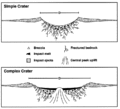Moldavite

Moldavite (Czech: Vltavín) is an olive-green or dull greenish vitreous substance possibly formed by a meteorite impact in Southern Germany (Nördlinger Ries), which would make it one kind of tektite. They were introduced to the scientific public for the first time in 1786 as “chrysolites” from Týn nad Vltavou in a lecture by professor Josef Mayer of Prague University, read at a meeting of the Bohemian Scientific Society (Mayer 1788). Zippe (1836) first used the term “moldavite” derived from the town of Moldauthein (Czech: Týn nad Vltavou) - now in Bohemia (the Czech Republic), from where the first described pieces came.
Contents
Origin
Moldavite's bottle-green glass colour led to its being commonly called Bouteillen-stein, and at one time it was regarded as an artificial product, but this view is opposed to the fact that no remains of glassworks are found in the neighbourhood of its occurrence; moreover, pieces of the substance are widely distributed in Middle to Upper Miocene and younger fluvial clays and gravelly sands in Bohemia and Moravia. The chemical formula of moldavite is SiO2(+Al2O3).
In 1900, F. E. Suess pointed out that the gravel-size moldavites exhibited curious pittings and wrinkles on the surface, which could not be due to the action of water, but resembled the characteristic markings on many meteorites. Boldly attributing the material to a cosmic origin, he regarded moldavites as a special type of meteorite for which he proposed the name of tektite. However, for a long time, it was generally believed to be a variety of obsidian. Because of their difficult fusibility, extremely low water content, and its chemical composition, the current overwhelming consensus among earth scientists is that moldavites were formed about 14,700,000 years ago during the impact of a giant meteorite in present-day Nördlinger Ries. Splatters of material that was melted by the impact cooled while they were actually airborne and most fell in Bohemia. Currently, moldavites have been found in an area that includes southern Bohemia, western Moravia, the Cheb Basin (northwest Bohemia), Lusatia (Germany), and Waldviertel (Austria).[1] Isotope analysis of samples of moldavites have shown a beryllium-10 isotope composition similar to the composition of Australasian tektites (australites) and Ivory Coast tektites (ivorites). Their similarity in beryllium-10 isotope composition indicates that moldavites, australites, and ivorites consist of near surface and loosely consolidated terrestrial sediments melted by hypervelocity impacts.[2]
99% of all moldavite finds have come from the South Bohemian localities, 1% were found in South Moravian localities. Only tens of pieces were found in the Lusatian area (near Dresden), Cheb basin area (West Bohemia) and Northern Austria (near Radessen). Principal occurrences of moldavites in Bohemia are associated with Tertiary sediments of the České Budějovice and Třeboň Basins. The most prominent localities are concentrated in a NW-SE strip along the western margin of the České Budějovice Basin. The majority of these occurrences are bound to the Vrábče Member and Koroseky Sandy Gravel. Prominent localities in the Třeboň Basin are bound to gravels and sands of the Domanín Formation.
In Moravia, moldavite occurrences are restricted to an area roughly bounded by the towns of Třebíč, Znojmo and Brno. Taking into account the number of pieces found, Moravian localities are considerably less productive than the Bohemian ones; however, the average weight of the moldavites found is much higher. The oldest (primary) moldavite-bearing sediments lie between Slavice and Třebíč. The majority of other localities in southern Moravia are associated with sediments of Miocene as well as Pleistocene rivers that flowed across this area more or less to the southeast, similar to the present streams of Jihlava, Oslava and Jevišovka.
Use
The total amount of moldavite scattered around the world is estimated at 275 tons.
There are typically two grades of moldavite: high quality, often referred to as museum grade, and regular grade. Museum and regular grade moldavites can be told apart by their appearance. The regular grade pieces are usually darker and more saturated in their green colour, and the surface is seen as closely spaced pitting or weathering. This type sometimes appears to have been broken apart from a larger chunk. Moldavite is also found to be compatible with borosilicate glass and can be fused to it with ease.
The museum grade has a distinct fern-like pattern and is much more translucent than the regular grade. There is usually a fairly big difference in the price between the two. High-quality moldavite stones are often used in hand-crafted jewellery.
There is a new moldavite museum in Český Krumlov, Czech Republic.[3]
References
| Wikimedia Commons has media related to Moldavite. |
- ↑ Lua error in package.lua at line 80: module 'strict' not found.
- ↑ Lua error in package.lua at line 80: module 'strict' not found.
- ↑ Lua error in package.lua at line 80: module 'strict' not found.
External sources
| Wikisource has the text of the 1911 Encyclopædia Britannica article Moldavite. |
- J. Baier: Zur Herkunft und Bedeutung der Ries-Auswurfprodukte für den Impakt-Mechanismus. - Jber. Mitt. oberrhein. geol. Ver., N. F. 91, 9-29, 2009.
- J. Baier: Die Auswurfprodukte des Ries-Impakts, Deutschland, in Documenta Naturae, Vol. 162, München, 2007. ISBN 978-3-86544-162-1
- Mindat with location data
![]() This article incorporates text from a publication now in the public domain: Lua error in package.lua at line 80: module 'strict' not found.
This article incorporates text from a publication now in the public domain: Lua error in package.lua at line 80: module 'strict' not found.

